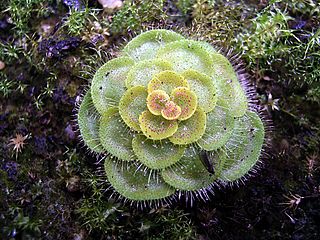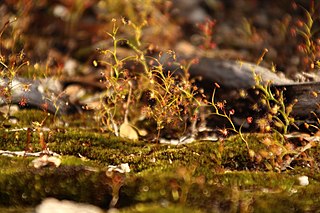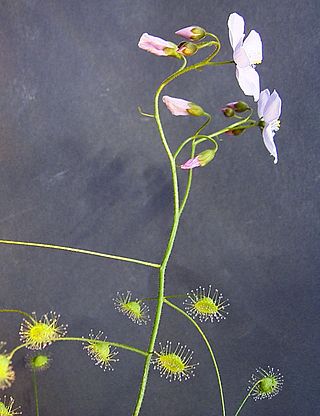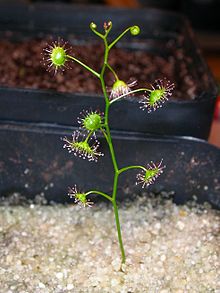
Drosera peltata, commonly called the shield sundew or pale sundew, is a climbing or scrambling perennial tuberous species in the carnivorous plant genus Drosera. Among the tuberous sundews, D. peltata has the largest distribution, which includes eastern and western Australia, New Zealand, India, and most of Southeast Asia including the Philippines. The specific epithet is Latin for "shield shaped", a reference to the shape of the cauline leaves. It is either a single extremely variable species, or a complex of several closely related species of uncertain taxonomic boundaries. In Australia at least four forms have had or still have specific taxonomic recognition: Drosera peltata subsp. peltata, D. peltata subsp. auriculata, D. foliosa and D. gracilis.
Drosera humilis is a perennial tuberous species in the genus Drosera that is endemic to Western Australia. It has 3 to 5 semi-erect stems that are 3 to 15 cm long with carnivorous leaves arranged in whorls around the stems. It is native to a region from the Moore River north to Kalbarri and east to Ajana and Wongan Hills. It grows in winter-wet sandy soils in heathland. It flowers from June to September.

Drosera stolonifera, sometimes referred to as the leafy sundew, is a tuberous perennial species in the genus Drosera that is endemic to Western Australia. It produces 2 to 3 semi-erect lateral stems that grow 10 to 15 cm long. It is most closely related to D. purpurascens, but differs by several characteristics including height and petiole length. It is native to a number of swampy locations around Perth south to Pinjarra. It grows in peaty water-logged soils in swamp heathland and flowers from September to October. After a bushfire it will flower en masse.

Drosera sect. Stolonifera is a section of ten tuberous perennial species in the genus Drosera that are endemic to south-west Western Australia. The species all have a similar growth habit and all have fan-shaped leaves, but the morphological differences and lack of natural hybrids support the division of the D. stolonifera species complex.

Drosera macrophylla, the showy sundew, is a perennial tuberous species in the genus Drosera that is endemic to Western Australia. It grows in a rosette with leaves 4 cm (2 in) long and 2 cm (1 in) wide. It is a common species east of Perth. It grows in loam soils. It flowers from June to October. D. macrophylla was first described by John Lindley in his 1839 publication A sketch of the vegetation of the Swan River Colony. In 1992, Allen Lowrie and Sherwin Carlquist described a new subspecies, D. macrophylla subsp. monantha, which is distinguished from D. macrophylla subsp. macrophylla by its single-flowered or rarely biflowered inflorescences. Subspecies monantha is abundant in the Bruce Rock/Merredin region.

Drosera erythrorhiza, the red ink sundew, is a perennial tuberous species in the carnivorous plant genus Drosera that is endemic to Western Australia. It grows in a rosette and is distinguished from the other species in section Erythrorhiza by its many-flowered cymose inflorescences with up to 50 individual flowers. D. erythrorhiza was first described by John Lindley in his 1839 publication A sketch of the vegetation of the Swan River Colony. In 1992, N. G. Marchant and Allen Lowrie described three new subspecies, thus also creating the autonym D. erythrorhiza subsp. erythrorhiza. The subspecies were separated from this variable species mostly by leaf morphology and distribution.

Drosera zonaria, the painted sundew, is a perennial tuberous species in the carnivorous plant genus Drosera and is endemic to south-west Western Australia from near Perth southeast to near Esperance. It grows in a tight rosette approximately 5 to 7 cm in diameter with 20 to 30 green to red leaves that are arranged in concentric layers. The leaves are typically 1 cm wide and are usually described as being "kidney-shaped" with crimson leaf margins. It grows in deep silica sands in open woodland or coastal heathland and only flowers after a bush fire, which is speculated to be caused by the release of ethylene. Its white, sweetly perfumed flowers, which are very similar to those of D. erythrorhiza, emerge on 4 to 5 cm tall scapes. As with most other tuberous Drosera species, D. zonaria will die back during the dry summer months and retreat to the fleshy tuber 10 to 30 cm below ground.

Drosera erythrogyne is a scrambling or climbing perennial tuberous species in the genus Drosera that is endemic to Western Australia. It grows in soils that are peat-sand to loam and occurs in an area along the southern Western Australian coast west of Albany in swamps or near granite outcrops. It produces small leaves along a long, scrambling stem that can grow to 2–3 m (7–10 ft) long. White flowers emerge from August to October.

Drosera gigantea, the giant sundew, is an erect perennial tuberous species in the carnivorous plant genus Drosera that is endemic to Western Australia. It grows in sandy soils at the margins of swamps and near granite outcrops along the Western Australian coast from Albany north to just south of Geraldton. D. gigantea produces small shield-shaped leaves along many lateral branches that look like a small tree. Individual plants can grow up to 0.2–1 m (0.7–3.3 ft) tall. Because of its tall, tree-like form, it is considered one of the largest Drosera species. It is also easily cultivated and enjoys damp, humid conditions often provided in greenhouses. White flowers emerge from August to November. The red tubers of this species can grow to be 3.8 cm (1.5 in) in diameter and may be a metre below ground.

Drosera macrantha, the bridal rainbow, is a scrambling or climbing perennial tuberous species in the carnivorous plant genus Drosera that is endemic to Western Australia. It grows in a variety of habitats, including winter-wet depressions in sandy, loamy, laterite, or quartzite soils. D. macrantha produces small, cup-shaped carnivorous leaves along a long stem that can be 0.16–1.5 m (0.5–4.9 ft) high as it climbs. Its 1 in (2.5 cm) white or pink flowers emerge from June to November, blooming earlier in the more northern range.
Drosera marchantii is an erect perennial tuberous species in the carnivorous plant genus Drosera. It is endemic to Western Australia and grows in a variety of habitats, including swampy areas and hilltops in laterite-silica sand soils. D. marchantii produces small, circular, peltate carnivorous leaves along stiff stems that can be 10–40 cm (4–16 in) high. Its pink flowers emerge from June to October.

Drosera microphylla, the golden rainbow, is an erect perennial tuberous species in the carnivorous plant genus Drosera. It is endemic to Western Australia and grows on granite outcrops or in sandy or laterite soils. D. microphylla produces small, circular, peltate carnivorous leaves along erect stems that can be 10–40 cm (4–16 in) high. It blooms from June to September, displaying its large golden sepals and smaller, variably-coloured petals. In populations near Perth, the petals are red, whereas petal colour near Albany tends to be orange. Some plants east of Esperance have white petals.
Drosera moorei is a scrambling or climbing perennial tuberous species in the carnivorous plant genus Drosera. It is endemic to Western Australia and grows near granite outcrops in sandy loam. D. moorei produces small, circular, peltate carnivorous leaves along glabrous stems that can be 12–35 cm (5–14 in) long. Inflorescences have two to ten yellow flowers and bloom from September to October.
Drosera neesii, the jewel rainbow is an erect or twining perennial tuberous species in the carnivorous plant genus Drosera. It is endemic to Western Australia and grows near swamps or granite outcrops in sand, clay, or laterite. D. neesii produces small, cup-shaped carnivorous leaves in groups of three along stems that can be 15–60 cm (6–24 in) high. Pink flowers bloom from August to December.
Drosera salina is an erect perennial tuberous species in the carnivorous plant genus Drosera. It is endemic to Western Australia and is only found in salt-free sand on the margins of salt lakes in a few locations north of Albany east to north-west of Esperance. The specific epithet, salina, refers to the salt lake margins that this species inhabits. D. salina produces small carnivorous leaves along stems that can be 7 cm (3 in) high. White flowers bloom from July to September.

Drosera stricticaulis, the erect sundew, is an erect perennial tuberous species in the carnivorous plant genus Drosera. It is endemic to Western Australia and is found near watercourses and granite outcrops in sandy clay or loam. D. stricticaulis produces small, cup-shaped carnivorous leaves along green, glandular stems that can be 25 cm (10 in) high. Pink flowers bloom from July to October.
Drosera subhirtella, the sunny rainbow, is a scrambling or climbing perennial tuberous species in the carnivorous plant genus Drosera. It is endemic to Western Australia and is found in sandplains, granite outcrops, and swamp margins in sand, clay, and loam soils. D. subhirtella produces small carnivorous leaves along stems that can be 40 cm (16 in) high. Yellow flowers bloom from August to October.
Drosera subtilis is an erect annual species in the carnivorous plant genus Drosera. It is native to northern Western Australia and a single site in the Northern Territory. In Western Australia, it has been collected from Beverley Springs Station, Bigge Island, and the Mitchell Plateau area all in the vicinity of the Kimberley region. In the Northern Territory, it has been found near Little Nourlangie Rock. It grows over sandstone near seepage margins in skeletal sandstone sand and black humus mixed soils. D. subtilis is anchored to the soil by a system of thin, fleshy roots and it lacks a tuber. It produces small carnivorous leaves along erect, reddish stems that can be 20 cm (8 in) high.
Drosera sulphurea, the sulphur-flowered sundew, is a scrambling perennial tuberous species in the carnivorous plant genus Drosera. It is endemic to Western Australia and is found in coastal areas in sandy loam, often among Cephalotus. D. sulphurea produces small, shield-shaped carnivorous leaves along stems that can be 40–60 cm (16–24 in) high. Yellow flowers bloom in September.

Drosera sect. Ergaleium is a section of 26 species that are erect or scrambling tuberous plants in the genus Drosera. This section represents a natural group and are taxonomically monophyletic.













